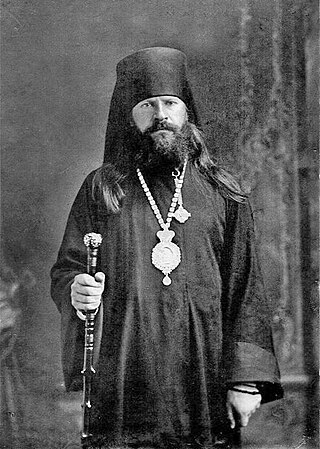
Tikhon of Moscow, born Vasily Ivanovich Bellavin, was a bishop of the Russian Orthodox Church (ROC). On 5 November 1917 (OS) he was selected the 11th Patriarch of Moscow and All Russia, after a period of about 200 years of the Synodal rule in the ROC. He was canonised as a confessor by the ROC in 1989.

Peter of Moscow was the Russian metropolitan who moved his see from Vladimir to Moscow in 1325. Later he was proclaimed a patron saint of Moscow. In spite of the move, the office remained officially entitled "Metropolitan of Kiev and all Rus'" until the autocephalous election of Jonah of Moscow in 1448.

Archbishop Andronik, was a bishop in the Russian Orthodox Church and a saint, glorified as Hieromartyr Andronik, Archbishop Of Perm in 2000.

Sep. 1 - Eastern Orthodox liturgical calendar - Sep. 3

Saint Philip II of Moscow was the Metropolitan of Moscow and all Rus' from 1566 to 1568. He was the thirteenth Metropolitan of Moscow to be appointed without the approval of the Ecumenical Patriarch of Constantinople as had been the norm.

August 13 - Eastern Orthodox liturgical calendar - August 15

January 24 - Eastern Orthodox liturgical calendar - January 26
The title of New Martyr or Neomartyr is conferred in some denominations of Christianity to distinguish more recent martyrs and confessors from the old martyrs of the persecution in the Roman Empire. Originally and typically, it refers to victims of Islamic persecution.

John Alexandrovich Kochurov, hieromartyr of the Soviet revolution, was one of a number of young educated priests who came to the United States in the late 1890s as missionaries among the émigrés from Carpathian Ruthenia and Galicia. He was active in establishing parishes and aiding communities, mainly in the Midwest. After returning to Russia he was assigned to Estonia where he put into action the teaching skills he learned in America before he was assigned in 1916 to Tsarskoe Selo. Here he was killed during the early days of the Bolshevik revolution. His feast day is celebrated on October 31. He is also commemorated on the Synaxis of the first martyrs of the American lands on December 12 and on the feast of the New Martyrs and Confessors of Russia, celebrated on the Sunday nearest to January 25, which was the date of the martyrdom of Metropolitan Vladimir of Kiev, the first of the new martyrs.

Metropolitan Nicholas, was the Metropolitan of Kiev in the Patriarchate of Moscow.

Metropolitan Anthony was a bishop of the Russian Orthodox Church in the Russian Empire, the Metropolitan of Kiev and Galicia, who after the defeat of Gen Pyotr Wrangel's White Army in South Russia in November 1920 emigrated and in 1921 settled down in Sremski Karlovci, Serbia. He, along with several other Russian bishops in exile, established an independent Russian church administration that sought to embrace all Russian Orthodox diaspora, known as the Russian Orthodox Church Outside Russia (ROCOR).

August 30 - Eastern Orthodox liturgical calendar - September 1

August 26 - Eastern Orthodox liturgical calendar - August 28

October 20 - Eastern Orthodox liturgical calendar - October 22

December 20 - Eastern Orthodox liturgical calendar - December 22

Nicodemius was a bishop of the Russian Orthodox Church, later the Archbishop of Kostroma and Galich.

Metropolitan Cornelius was an Estonian metropolitan bishop of Tallinn and All Estonia, the head of the Estonian Orthodox Church of Moscow Patriarchate.

Metropolitan Anastasy was a hierarch of the Russian Orthodox Church and the second First Hierarch of the Russian Orthodox Church Outside Russia.

New Martyrs and Confessors of Russian Church is group of saints of the Russian Orthodox Church martyred or persecuted after the October Revolution of 1917. Their memorial is held annually at the end of January or beginning of February.












